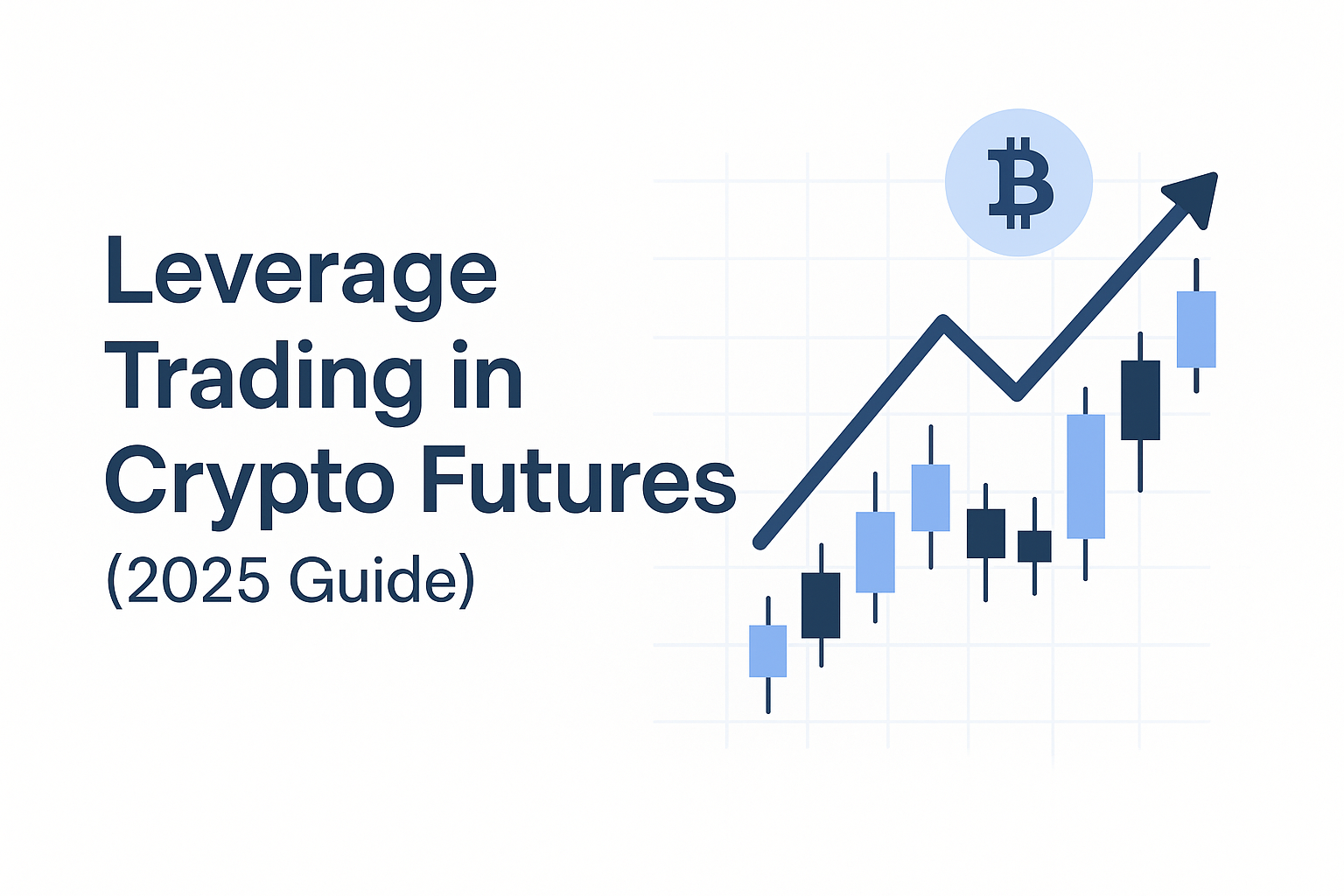Futures trading has been one of the most-discussed strategies in crypto as well as traditional markets.
It gives individuals the opportunity to make money not only when prices rise, but when they fall. This is attractive to traders who don’t want to wait years before reaping a profit. The system functions on a rapid level, and that’s part of why many short-term investors like it. The crux of this approach is a concept called leverage, which allows traders to open larger positions even if they’re not wealthy. That might sound thrilling, and it is — but it is also seriously risky. Just one bad decision in a leveraged trade can erase your entire investment. This guide was written for a complete novice to understand how futures trading works, the leverage that profit and risk can be enhanced with, and for a beginner trader to know if he is trading safely.
What is futures trading?
Futures trading is a form of finance contract. Here’s how it works: With a futures contract, two people agree to buy something or sell something else — say, Bitcoin, oil, gold or the S.&P. 500 stock index — at a specific price on a date in the future. The trade itself is not executed immediately. Instead, each side here locks in the price now and transacts one time in the future. The idea is usually not to own the asset. T
he aim is to profit from the fluctuations in price. For instance, if a trader is betting that Bitcoin will rise, they would open a “long” futures position. If the price does rise, they have made a profit. But if it falls, they lose. Conversely, they can also “short” the asset if they think the price will drop. This style of trading enables you to profit in both directions.
That’s why it’s free and very popular — particularly in crypto, where prices change quickly. But because you don’t actually own the asset, you make or lose money based solely on whether the price moves in your favor. Small price differences can move the needle on your money, especially when you’re using leverage.
What does “leverage” mean?
Leverage is what allows you to trade with more money than you have in your account. For instance, if you have $100 and apply 10x leverage, you can open a position worth $1,000. You can borrow the other $900 from the exchange. That way you have the power to make more money, as long as your prediction is correct. But if the market moves against you, your losses will also be greater. Indeed, you risk losing all your money if the price moves only 10% in the wrong direction.
That is known as liquidation — the exchange closing your position for you in order to protect the money that you borrowed. Leverage is a force multiplier: It can increase your gains, but it also amplifies your risks. Many people are unaware of this, especially beginners in trading. They watch influencers or traders posting videos of massive gains with the aid of 50x or 100x leverage but they are unaware of how fast and furious they could lose it all if they were to follow a similar gameplan. Hence the need to use leverage with iron discipline and a clear risk management plan.
Why leverage is so popular in the crypto and stock markets
Leverage is so alluring because it enables people to earn more money without having to have a lot of money. Leverage lets traders turn what would normally be small price movements into big profits, and losses, in crypto markets, where prices can jump 5% to 10% in a few hours. With as little as $50 or $100, a trader can make a deposit and carry out trades valued at several thousand dollars. This is a very tempting proposition to people looking to rapidly grow their account. Stock traders also lean on leverage, particularly when trading during big events like earnings releases or interest rate decisions.
A side effect of these events is that they prompt quick price changes, and leverage enables traders to profit on those short-term moves. Another reason for the ubiquity of leverage is that most trading platforms encourage it. They make it user friendly and even have high limits up to 125x: On social media, you can find many traders posting screenshots of massive wins on high leverage, which brings others into the fold.
But with every big win comes many, many quiet losses that are never posted. There is nothing wrong with losing trades because we all lose trades. But beginners lose most of the time, because they have no idea how to protect their capital. They overleverage and take large risks and get liquidated quickly.
Leverage: Is it good for new traders?
By far, most would say newbies should stay away from high leverage, at least when they are just starting out. It’s best to learn to how to trade with either very little or none at all leverage first. Beginner traders do think with their emotions, don’t respects risk management and looking for fast money. Leverage amplifies all of these errors.
A single bad trade can empty it out in minutes. That’s why it’s safer to start with 1x or 2x leverage and increase it only once you know how the market works. The use of demo accounts can also be useful. It lets you dry-run your strategies without risking real money. After you’re comfortable and disciplined, you can slowly move into more leverage — and even then, you can use it carefully. Taking big risks is not the key to success in futures trading.
It comes from defending your money, thinking straight, and making plans and acting. German: Geduld und Übung sind wichtiger, als die schnelle Mark zu machen. If you are a beginner, the answer is yes, but give yourself time. Educate, get better, and reciprocate that effort.
How Leverage Works in Futures
Leverage is one of the greatest things about trading futures. It lets traders open larger positions with less money. Using leverage, one can increase both the profit and loss, depending on how the market moves. It may sound exciting and quick to make money and it usually feels relaxed when you earn money fast, but quick money is also a quick reason for traders losing their money. This article describes how leverage really works written in a way that is easy for the novice to understand with use of examples. Leverage can enhance returns when used judiciously. But in the wrong hands, it can decimate a trading account in minutes.
Basic example: 10x leverage explained
So, for instance, if you have a $100 in your futures trading account. If you apply 10x leverage, you are now able to open a trade valued at $1,000. That is, the exchange is allowing you to borrow $900 more. Now you are not trading with only your capital — you are trading with more buying power. If the price of the asset increases by 5%, your $1,000 position would be worth $1,050. On this trade your gain will be the $50 you earn, a 50% return on your $100 invested. Without leverage, that same 5% change in price would have given you only $5. This is why leverage can be such an effective way to escalate profits — but there’s a trade-off.
Small margin, big trade
With leverage, you can trade with a smaller amount of money by using a margin. This amount is called margin. Furthermore, with a 10x leveraged trade, you only need to put up 10% of the full trade size. So you can control $1,000 with only $100. The smaller your margin, the larger your leverage. It is this low margin that allows many people to trade bigger amounts of what they can afford. It is, in fact, the primary reason leverage is so popular, particularly in the world of crypto. But remember, the trade size is big — which means even small price changes will have an outsize impact on your position.
How profits can grow fast
Traders adore leverage mainly because it boosts their potential profits. A tiny shift in price can result in huge returns. If you make the same 3% with your 10x trade, you’ve actually just made 30% of your margin. So, with little money, people can now make money fast — especially in crypto, which sees 5% to 10% price moves every single day. Returns are larger with more leverage, say 50x or 100x. It’s also why high-leverage trading is so alluring to so many — it provides the opportunity for big rewards with a small investment. But those quick gains also come with grave risks.
How losses can grow too
Losses, like profits, can accumulate quickly when trading on leverage. Even in a play that is only 10x leveraged, the price drops just 10% and poof, you lose your entire $100. This is known as liquidation, in which the exchange automatically closes out your trade to stem further losses. The greater the leverage, the less the price must move to cause liquidation. A lot of new traders get iced without an appreciation for how quickly it can happen.
What may appear to be a relatively modest downward move can blow up an investor if the level of leverage is too extreme. That’s why mitigating risk is more important than going after short-term gains. Although leverage can be Your Friend, when there is not a stop-loss and you’re just free-riding or gut trading it can become your Enemy.
Types of Leverage Used
There are different levels of leverage and each of them can affect the risk and reward in different ways. From mild 2x leverage to impossibly high 100x ratios, traders can really decide how aggressive they’d like to be. But leverage is not just about how much you borrow — it’s also about how your losses are managed over the course of a trade.
That’s where cross margin and isolated margin come in. These types of leverage and margin settings are important to understand before you begin trading any futures position. Select the wrong type and your risk of liquidation goes up. In this part, we’re going to cover the meaning of each leverage level, the work of margin modes, and which one is more appropriate for newbies.
2x, 5x, 10x, 100x: What Does It All Mean?
These numbers — 2x, 5x, 10x, 100x — are the leverage multiplier. With 2x leverage you are trading with twice your actual money. With a 10x position, your $100 is controlling a $1,000 position. At 100x, your $100 position becomes a $10,000 trade. Leverage is the borrowing of money from an exchange to maximize (or “leverage up”) the size of your position; the higher the leverage used, the more money borrowed and the smaller the price move required to liquidate your position.
A 1% move backward in price could easily eradicate a 100x position toward the waning days of a contract. That is why high leverage is extremely risky and typically used only by experienced traders — who are able to ignore these outsized correction risks — for short, high conviction trades. For learning and developing discipline, a low[ish] level of leverage (2x–5x) is exponentially more safer.
Cross margin vs Isolated margin
These are the 2 primary types of margins settings that can be used in futures trading. Isolated margin is when only the funds deposited for that specific trade are used as margin requirements and nothing else. If the trade does not work out, only that amount is at risk — not your entire deposit. This is more control and is good for risk management. Cross Margin, on the other hand, which puts your entire wallet as collateral for open positions.
In case of adverse move of one trade, you send your wallet to cover the liquidation. While cross margin may help save trades from closing too soon, it also increases the overall risk — because all your funds are at risk. The Isolated margin is also popular among the starter traders since it restricts the extent of losing, ensuring the balance is protected.
Which one is best for beginners?
As a beginner, lower leverage and isolated margin is the way to go. These settings minimize the risk of liquidation and offer more control over your losses. Technical-tarding and emotional stability along with experience is needed to keep trading using high leverage and cross margin. New traders are often too eager and get involved in 20x, or even 50x trades with cross margin, under the impression they will make quick profits.
But if the market turns even a little against them, they lose much more than anticipated. Small moves. Small gains. Small losses. Keep learning and protecting your capital. When you grow comfortable, and more experienced, you have the ability to dabble with more advanced settings, such as cross margin, but your primary concern in the beginning should be safety and stability.
Leverage in Crypto Futures
Puts are the mere reflection of calls in the world of crypto futures. The crypto market is extremely volatile, so minor price fluctuations can make big profits — or devastating losses. Leverage used by traders increases their exposure with limited funds. This has made the futures trade very popular in the crypto world, especially because of the possibilities for short-term gains. But where there is money to be made, there’s also risk, and the leverage used needs to be supported by knowledge and risk control. In this guide, you’ll learn why traders use heavy leverage in crypto, where to find the best options, and pitfalls to look out for trading coins like Bitcoin and Solana.
This is why crypto traders use high leverage
The vast majority of crypto-traders are attracted to leverage because it enables them to grow their account quickly. With 10x, 50x, and even 100x leverage, they can make big trades without putting down much money. For instance, with $100, a trader is able to open a position as large as $10,000 with the help of 100x leverage. If the coin goes up 1%, then you have made a 100% return on your original $100.
In a market that moves as quickly as the current one, a few minutes can make a huge difference. It is this speed and earning potential which makes leverage interesting, especially for scalpers and day traders. But this shortcut to riches also means you’re a single mistake away from total liquidation. Nevertheless, for some, the power of growing small capital into big gains is worth the risk — and that’s why an eye-wateringly high leverage is still popular within crypto.
Top leverage platforms (Binance, Bybit, etc.)
There are numerous trading platforms which support leveraged futures trading, but some are more recognizable and secure than the others with extra features. Binance – The world’s biggest crypto exchange including futures and margin trading and up to 125x leverage on selected pairs. It also includes functionality such as cross margin, isolated margin, stop loss, and take profit.
Another of the leading choices is Bybit, which has a clean interface, speedy execution, and up to 100x leverage on major coins, including BTC and ETH. Other well-regarded exchanges include OKX, KuCoin and Bitget, also providing high leverage and tools for beginners. And many of these platforms have demo accounts and educational resources, so new traders can practice before risking real money. These are useful features, but ultimately, a trader’s success will be based on their discipline, planning and risk management.
Risks to BTC and SOL in volatile coins
It’s no secret that coins like Dogecoin (DOGE) and Solana (SOL) are famous for their price swings. One candle can cause a price to move up to 3–5% in several minutes. Your position can get wiped out quickly if high leverage is used on such coins, with a small move in price. For instance, in a 50x position on SOL, a 2% slip could lead to full liquidation. And such price swings can allow for quick profits to be made — but they also make it possible for quick losses.
New traders often lose money trading volatile coins since they trade without a proper strategy and don’t set stop loss orders. Even for seasoned traders, high leverage trades on fast moving coins is risky, so additional caution should be considered when using leverage. The crypto market never sleeps and is influenced by news, social media and bold investor moves. That’s why the control of emotions and the size of positions matter more here than in traditional markets.
Benefits of Using Leverage
In 2025, upside down in Bitcoin over $95,000 with raging altcoins, such as Solana and Chainlink, still maintaining elevated volatility, traders are growing higher on leverage than ever before. Futures trading has become the go-to game of choice for retail and institutional investors, and is used not only to juice profits, but to hedge risk after years of uncertain markets. When employed responsibly, leverage provides a number of key benefits – particularly in fast-moving markets like crypto where 3-5% daily swings often occur.
Platforms like Binance, Bybit, and OKX offer adjustable leverage tools and risk management in real-time, enabling traders the ability to scale trades without getiling failing up risk. In this section, we’ll examine the key real-time advantages of leverage that crypto traders have in 2025.
Bigger trade with less money
Even small retail traders now are engaging in trades of thousands of dollars at least by leverage as of 2025. Take 100x leverage on Bybit or Bitget as an example, a trader only need to pay $200 to open a position on BTC worth $20,000. This means they are able to be part high-value trades that use to be the preserve of the big players.
This “capital efficiency” is particularly useful when market volatility is heightened, such as during Bitcoin ETF announcements or Ethereum layer-2 network upgrades. Leveraging with small capitalizing to have a larger position positions the trader to hedge his holdings or employed strategies across various ranges, freeing up funds available for use in other operations like spot holding or staking.
More Opportunities to Make a Profit over a Short Period of Time
By 2025, crypto market environments are much more reactive to macro events — an interest rate change, a regulatory decision or a whale’s move can send prices skyrocketing or plummeting in moments. Due to leverage, traders can make money on these fast swings even if the price move is only 1–2%. For instance; when the U.S. Fed hinted at a policy pause in April of 2025, Bitcoin rallied more than 6% in a couple of hours. Leverage 10x traders made 60 per cent in one session. This type of quick trade is only achievable because leverage increases profits from even the smallest price movements. It is not just a feature anymore — in 2025, leverage is a really big edge, for time-sensitive traders and scalpers.
Useful in short selling too
As Bitcoin and altcoins respond aggressively to news — such as SEC lawsuits, exchange hacks and token unlocks — short selling has become just as prevalent as longing. You can do this on platforms like Binance Futures, OKX and dYdX and use leverage to short, meaning you can bet that the price will go down and still make profits. For instance, when Solana tanked 15% in March 2025 because of a big token unlock, traders shorting it on 5x or 10x lever saw handsome profits. This ability to long uptrends and short downtrends with leverage enables traders to remain active in all market conditions — falling market included — and not just during bull runs.
Risks and Dangers
Leverage provides the sort of exciting rewards more like an early adopter in crypto user growth while also creating some of the most dangerous risks in crypto trading. And in 2025, as the futures market is infiltrated by increasing numbers of traders using platforms like Binance, Bybit, and Bitget, liquidation events and latent losses are occurring more often. High potential trading opportunities for both bull and bear markets because often in a strong trend, market can be bullish or bearish while good news were released (suitable for a leveraged trade)
2. Many novices are drawn in hoping to make fast money, but with no risk management they’re soon blowing their accounts in a matter of minutes. In this part we will discuss the main threats of leverage, what liquidation actually is, how you can plan to avoid getting completely wiped and more.
What is liquidation in layman’s terms
Liquidation occurs when the market moves so far against your position that your remaining margin can no longer cover the trade. The exchange then automatically closes your position, so it doesn’t lose the borrowed money. For instance, trade with 20x leverage and the price goes against you by a mere 5%, and your position can be liquidated. Which is to say, your original money — the stuff in your account known as margin — has been lost.
In plain English, liquidation is the platform telling you, “You don’t have enough skin in this game, so we’re going to make it for you,” and closing your trade whether you want it to or not. The greater the leverage, the less of a price movement is required to liquidate.
How traders can go broke instantly
In 2025, a certain crypto can jump from high to low and back high within minute (particularly if it is BTC, SOL or PEPE) depending on the news, whale orders, and massive liquidations. A trader will get wiped out of his whole account due to a small dip even with high leverage if there is no planning.
For instance, if a trader has only $500 and is using 50x leverage on a fast-moving coin, they can be wiped out when the market moves against them by 2%. Lots of newcomers believe leverage is a way to ensure profit — in fact, it multiplies loss just as quickly. With no stop-losses but still potentially unlimited loss, traders end up losing what they don’t want to (or sometimes their entire futures wallet balance in the case of cross margin mode).
Significance of stop loss and planning
Do you know what Stop-Loss is a feature that helps you automatically cut your losses? In 2025, in an age where market news travels at breakneck speed via Twitter or Telegram, the stop-loss has rarely been more important. Without 24/7 access to the chart, a price move out of nowhere can lead to rapid liquidation before you’ve even realized that anything’s changed. A stop-loss ensures it’s closed at a safe point, before that danger area is reached. Planning also involves deciding how much you will risk per trade, how much leverage you will utilize, and which price you are aiming for.
A lot of pro traders are known for following the “2% rule” — they avoid risking more than 2% of their account’s value in any one trade. Sound planning, achievable goals and the use of instrument such as stop-loss are not a choice, but a necessity for survival in trading of futures.
Leverage vs. Spot Trading
By 2025, both spot and futures trading are common practice for crypto investors, but that is where the similarities end in terms of risk and experience. Spot trading is straightforward — you buy the asset and keep it. Futures trading, however, works with leverage, margin and contracts that may not necessarily cover ownership of the actual coin.
Hardly! It’s just a myth that so many new traders seem to get wrong or completely misunderstand how leverage basically change the entire risk profile of the trade. This article deconstructs the differences, discusses which is safer, and describes when isolating leverage is a smarter decision.
The crucial distinctions of futures against spot
In a spot trade, you buy a crypto asset with your full cash. If you purchase 1 ETH for $3,000, you hold that ETH and can keep it, send it or sell it at any time. They are not facing liquidation. Your profit and loss are only a function of how the market moves over time. In futures trading, you don’t hold the coin. Rather, you sign a contract that depends on the coin’s price movement — up or down. You can leverage up the trade size, however you have liquidation risk with it.
Futures also have the option of taking a short position, meaning you can make money when prices go down, whereas spot trading only makes you money when prices go up. Spot is simpler, slower, and typically bears the character of long-term investment. Futures are quicker and more complicated, and better suited to active, short-term strategies.
Which one is safer?
Too, because spot trading is safer, and better for beginners. Since it is your own money and your own ownership of the asset, it doesn’t make sense to get liquidated. But even if the price drops, the coin is in your possession and you can sit back and wait for the price to recover. With futures trading, one wrong move and it’s bye-bye investor and account, as your position is closed out and your money gone. That’s what leverage and margin do. In spot, you manage your full risk. When trading futures, risk can blow up if you don’t use proper settings. So for people who are new to all this, or are like many others who have an aversion to snap judgments, spot trading is the more prudent and lower-stress option.
When do you not want to use leverage?
Stay away from using leverage during high volatility market situations, such as major news, token unlocks, or unstable political conditions. In 2025, we’ve watched Bitcoin surge in response to Fed policy changes, Solana swoon after a whale exit, and meme coins like DOGE pump and dump in the span of hours. If you are not used to coping with swings like these, you’d be better off avoiding leverage during such phases. Also if you’re trading emotionally, without a stop-loss, or simply taking the advice of influencers without a thought — steer clear of leverage. It’s also not appropriate if you are trading borrowed money, or if you are trading with money that you can’t afford to lose. Just remember: Leverage is a tool — not a shortcut. You can grow your account quickly with it, but faster if you’re not using it strategically.
Ways to Trade Leverage Safely
Fast, accessible — and riskier — futures trading in crypto In 2025, crypto futures trading is faster, easier and riskier. With platforms such as Binance, Bybit and Bitget offering up to 125x leverage it is easy for traders to get carried away. But with such power comes great danger. Many newbies lose their entire accounts in minutes due to mishandling of leverage or failing to plan their trades properly. To trade leverage secured, you need more than capital — you need discipline, strategy and patience. Here are some established strategies to keep you safe and sane when trading with leverage in crypto futures.
Begin at low leverage (2x or 3x)
When you are just starting, the most intelligent thing to do is to use low leverage. At 2x or 3x it’s more than you have as a position, and there’s much more overhead before you get liquidated. If you are using 2x leverage for instance, the market would have to moved over 40% in the wrong direction before you get liquidated. That is so you have time to react, dissect, and manage your trade. Both dozens of good traders in 2025 still prefer low leverage for high quality setups, it offers more control and less stress. Going in small helps build skills without putting your entire wallet on the line.
Trade never without a stop
It never traded him without a stop and he insists that was extremely important to him.
Your emergency brake is your stop-loss. Without one, all it takes is one bad candle for you to get liquidated in part or in full in seconds — especially on high leverage. It’s 2025, and word is getting out about some news in crypto. A single whale tweet or sudden policy shift can move BTC or ETH by 5–10% overnight. All are sound methods that protect your capital by getting you out of a trade before it moves too far against you.
Exchanges such as Bybit and OKX are now providing sophisticated stop-loss functions such as trailing stop and partial exit. It is not a matter of weakness getting in the way of you using them, it is what keeps your trading account alive in case of unpredictable moves.
Do not invest all your money
It is never wise to put your entire balance on the line in one trade, however confident you may feel. The best way to trade leverage is to use only a small portion of your funds — that is, ideally, no more than 5% of your stack per trade. With $1,000 in your futures wallet, for example, you can enter a trade with only $50 to $100 in margin. In this manner, you’ll be stuck even if the trade doesn’t work out, but you’ll have some cash to regroup. This is how many of the smart traders in 2025 survive for longer and remain in the game, unlike the others who blow up, f**k off and fail chasing quick profit.
Get educated before you trade on high leverage
Extremely high leverage, like 20x, 50x, or 100x should be reserved for when you’ve gained some experience. It may be tempting to double your profit fast, but your chances of being liquidated are astronomical. If you don’t understand margin, funding rates or how liquidation works, high leverage will be more harmful than helpful.
Many platforms today provide demo trading and backtesting tools — take advantage of them to develop skill before you risk real money. True success in futures trading isn’t about high risk, it is about high discipline. Treat leverage as you would a sharp tool — potent when employed thoughtfully, but disastrous in the wrong hands.
Common Mistakes to Avoid
Leverage trading can be lucrative — but only when applied with knowledge, control and discipline. In 2025, a new cohort of thousands of crypto futures traders are looking to make money fast and double their money overnight. But instead, most end up losing everything — not because the market is rigged against them, but because they make simple errors. These mistakes can be prevented when you trade with a proper plan and also learn from the experience of others. We will discuss the biggest fail for most traders when they blow accounts up with leverage such as with Binance, Bybit, Bitget as well as other platforms.
Going all-in on one trade
One of the greatest errors that novice traders make is jeopardizing all they have with a single trade. It doesn’t matter if it is confidence, greed or desperation — when you go all-in, there is no second chance when the market moves against you. High-confidence setups themselves can be shattered in 2025 from unexpected news, from whale decisions, from big accounts’ liquidations. For instance, you can be 100% confident ETH is going to pump, but the moment it drops 5% on your leveraged trade, you might lose everything in your account.
Successful traders always split their capital, trade with tight margins and know nothing is a sure thing. A good rule of thumb is to avoid risking more than 2% to 5% of your total funds on one position.
Beginner 50x And 100x For Using
High leverage such as 50x or 100x is often hawked by influencers who display screenshots of massive such gains. But what they fail to mention is how readily these trades can be reversed. If you apply 100x leverage, you could enter a trade that gets wiped with a 1% move to the downside. Markets such as Solana and PEPE can see a movement in seconds that is more than 1% in 2025, particularly in the weeks of token unlocks or market dumps.
Novices frequently dive into these high-leverage trades without a stop-loss, believing they will be able to get out in time. But it’s generally too late by the time they do react. High leverage is only appropriate for experienced traders who can handle it — and even then, it should be used cautiously.
Excluding funding costs and liquidations
Most traders focus only on entry and exit prices — and ignore funding fees, which are assessed every 8 hours in perpetual futures. In 2025, pairings are significantly more aggressive now on BTC, ETH, and trending altcoins like MEME or DOGE. If you maintain a leveraged position for a few days, these fees can eat in to and even wipe out your profits. Plus, most beginners don’t even understand liquidation levels.
They believe the trade will come back, and they wait too long to act — until the platform ultimately auto-liquidates their position. This not just liquidates a trade, but does so with penalties. Always monitor the funding rate, work out your liquidation price before you enter and never leave trades open without protection.
After the hype or random signals
In crypto, social media-driven hype travels faster than fair information. In 2025, lots of traders take positions according to Telegram signals, influencer tweets or TikTok videos — without taking a glance at the chart or considering the setup. Just because someone else made money on a coin doesn’t mean that trade will work for you. The bulk of hype-based trades happen late, after the train has left the station. For example: If there’s a meme coin than ran up 200% last few hours, entering the position post “FOMO” results in more often than not, losing that money. Successful traders develop their own plans, backtest them and trade off of clear setups — not random noise they picked up off the internet.
Top List with Tools for Leverage Trading in 2025
By 2025, leverage trading has gotten smarter — not merely riskier. The biggest exchanges such as Binance, Bybit, OKX, and Bitget today provide such advanced tooling, to help traders manage their risk, calculate margin requirements and make smarter trades. But tools alone are insufficient, because tools alone say nothing about the person who is using them.
Losses from trading often occur not because a trader made a bad trade, but because he or she failed either to use the tools available to them or to take advantage of them. Here in this article, we will take a look at the most important tools every leverage trader should use in the fast paced world of cryptocurrency today.
Margin calculator
You can use a margin calculator to determine how much capital is required to open and hold a leveraged position. It also displays your liquidation price — the price at which the exchange will liquidate your position. And by 2025, most major platforms have incorporated calculators directly. For instance, Bybit allows you to type your margin size, leverage, and entry price, and it will immediately calculate your liquidation level and maintenance margin for you.
By using a calculator before trading, you can avoid surprises and plan for the worst there is. It also makes your trading more scripted, less emotional and willy-nilly.
TradingView for analysis
TradingView is once more the fave charting tool for traders as we head towards the end of 2025. Whether you trade with 10x leverage, or 50x, proper chart analysis is needed. As a TradingView member you have the ability to draw support / resistance levels, apply technical analysis as RSI or MACD and follow key trendlines on our chart before pulling the trigger on a trade.
Many of these exchanges, like Binance or Bitget, now have TradingView right in their platform, so you can do your analysis and execute your trades without ever leaving the app. A well-defined chart plan guides your decision making of entry, take profit and stop loss levels (which are all important in leveraged trades).
Risk management tools in exchanges
Today’s exchanges even have risk controls that you can set to help you protect your funds. By 2025, platforms like OKX and Bitget let you set maximum daily loss limits, margin caps, and reminders, to notify you when you reach a risk limit within your account. These functionalities would be perfectly suitable for those who over trade or go chasing losses after they get liquidated.
Some platforms now provide AI-driven alerts which can spot reckless trading behavior and warn you in time. When you use them properly, you can stick to your trading plan and keep your feelings from making you a cautionary tale of big trading losses.
Auto-stop loss settings
Stop-loss is your 1# protection when you are trading on leverage — now it’s smarter! By 2025, auto-stop loss features will enable you to set price, percentage, or even technical indicator-based exit points ahead of time. For instance, you can decide to close your position if BTC drops 2%, or RSI falls below 30. Nowadays, many platforms offer trailing stop-losses, which follow the market to your advantage and then automatically lock in more profit. Powerful auto-stop loss will ensure you never lose more than you should — even if you are not at your computer or looking at the chart.
Conclusion
They are cursed with leverage. Now in 2025, it’s making thousands of traders unbelievable profits — but it’s also making too many traders blow up their accounts in seconds. You can control massive positions through the use of leverage with relatively little capital, exploit short-term price movements, and potentially turn a profit during a price decline.
All this, however, comes at a price — greater risk, higher chance of liquidation and emotional stress. Loads of beginners get lured in by 20x, 50x and even 100x leverage with absolutely no idea of a plan of entry or exit and get wiped out because they are gambling for quick profits. If you truly want to benefit from leverage, you have to start with baby steps, understand how margin and liquidation work and truly know how related tools that exchanges like Binance, OKX and Bybit give you access to work.
Trade on demo accounts, always use a stop-loss and never trade without knowing your risk. Smart trading is better than fast trading. Profits will come — only if you protect your capital and nurture your skills over time. Ultimately, it’s not leverage that is the enemy — it’s lack of discipline.
Rapid-Fire FAQs – What’s leverage trading on crypto futures?
What does leverage mean in crypto trading?
The leverage allows you to trade with more money than you have. Its $100 stake becomes a $1,000 investment with 10x leverage. It boosts profit — and risk.
Is leverage trading risky?
Yes. If the market turns against your trade, your position can get liquidated fast — especially with high leverage (50x or 100x).
What does liquidation mean?
Liquidation refers to when your trade is having substantial losses the exchange has to close it out. Your margin is gone to back the money that you had borrowed.
How much leverage is right for a beginner?
Start with 2x or 3x leverage. It affords more control, diminishes pressure and lessens the likelihood of a quick liquidation job.
What’s spot trading compared to leverage trading?
Spot trading is where you buy and hold actual crypto. In leverage trading you don’t own the coin — you bet on price moves, but with higher risk.
Can I lose more than the value of my margin?
In cross margin mode, yes. Your entire futures wallet can be used to cover losses. Use isolated margin to restrict loss to only one trade.
Which platforms are tops in 2025?
Binance, Bybit, OKX, and Bitget have high leverage, live tools, margin calculators, and robust risk features for beginner and advanced traders.
What are funding fees?
Fees An interest fee is charged on open positions every 8 hours. You will pay or receive a nominal sum depending on the market’s sentiment.
How do I calculate the liquidation price?
You can use inbuilt calculators on the exchange. Enter your leverage, margin and entry price — the tool will follow the liquidation level in real-time.
50x or 100x leverage, which one is better?
Not recommended. High leverage is dangerous and can swallow your capital with small price movements. It’s something beginners should not even be touching.









